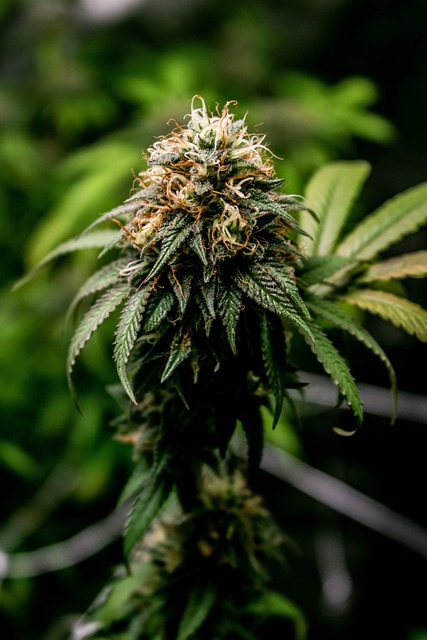High potency cannabinoids (HPCs) like THC and CBD are central components of the Cannabis sativa plant, renowned for their therapeutic potential and robust effects due to high concentration levels. These compounds interact with the human endocannabinoid system, influencing a range of physiological processes and offering benefits from pain management to anxiety reduction. Current scientific research emphasizes understanding HPCs' pharmacokinetics to ensure safe and effective use. The study of entourage effects within the plant is also gaining traction, which could enhance the efficacy of cannabis-based therapies. As legal frameworks adapt, accessibility to HPC products has increased, necessitating comprehensive educational initiatives on their use and benefits. These compounds are now consumed through various forms including oils, edibles, topicals, tinctures, and transdermal patches, providing versatile options for consumers. Research continues to uncover the full potential of HPCs in treating a variety of conditions, with a focus on optimizing their pharmacokinetics for better health outcomes. The regulatory environment for HPCs varies globally, with some regions embracing their use and others maintaining strict prohibitions. As the industry advances, it is poised to deliver significant therapeutic benefits through tailored formulations and dosing strategies, marking a pivotal moment in cannabinoid science.
Exploring the intricacies of high potency cannabinoids (HPCs) reveals a complex interplay of science, legality, and consumer safety. This article delves into the transformative potential of HPCs, offering a detailed examination from their scientific mechanisms to the evolving legal status across regions. We’ll navigate through the top high potency cannabinoids, their discernible effects, and provide critical dosage and safety guidelines for responsible use. Additionally, we’ll explore innovative methods of consumption, and what the future holds for HPCs in terms of research and development. Join us as we uncover the essential aspects of this burgeoning field.
Understanding High Potency Cannabinoids: A Comprehensive Overview

High potency cannabinoids represent a subset of cannabinoid compounds found within the Cannabis sativa plant that exhibit strong effects due to their high concentration levels. These compounds, including THC (tetrahydrocannabinol) and CBD (cannabidiol), interact with the body’s endocannabinoid system, influencing various physiological processes and health outcomes. The study of these potent molecules has gained significant traction in scientific research, as their therapeutic potential is being increasingly recognized for conditions ranging from pain management to anxiety relief.
Research into high potency cannabinoids focuses on understanding their pharmacokinetics, including absorption, distribution, metabolism, and excretion, to ensure safe and effective use. Additionally, the exploration of these compounds’ entourage effects, where multiple cannabinoids work synergistically, is a burgeoning field that holds promise for developing more targeted and effective cannabis-based treatments. As regulations evolve, the availability of high potency cannabinoid products for both medical and recreational use continues to expand, prompting a need for comprehensive education on their properties, potential benefits, and associated risks. Understanding the nuances of high potency cannabinoids is paramount for healthcare providers, patients, and researchers alike as this field of study progresses.
The Science Behind High Potency Cannabinoids: How They Work

High potency cannabinoids (HPCPs) are a class of compounds found within the Cannabis sativa plant that have garnered significant scientific interest due to their therapeutic potential. These naturally-occurring chemical entities, including THC (tetrahydrocannabinol), CBD (cannabidiol), and others like CBN (cannabinol) and THCV (tetrahydrocannabivarin), interact with the human body’s endocannabinoid system (ECS). The ECS is a complex network that plays a pivotal role in regulating various physiological processes, including mood, pain sensation, inflammation, and memory.
The efficacy of high potency cannabinoids stems from their ability to bind with high affinity to cannabinoid receptors found throughout the body. These receptors are part of the ECS and are categorized into two main types: CB1 receptors, predominantly located in the central nervous system, and CB2 receptors, which are more prevalent in peripheral organs, particularly immune cells. The specific interactions between HPCPs and these receptors can lead to a wide range of effects, from the psychoactive high associated with THC to the anti-inflammatory and analgesic properties of CBD. Research into HPCPs is ongoing, aiming to unravel their full potential for therapeutic applications, as well as to understand the mechanisms behind their varied effects on human health and disease states. The precise dosing and delivery methods of these compounds are critical factors in optimizing their medical benefits while minimizing potential side effects, a subject of intense scientific scrutiny. Understanding the pharmacokinetics and pharmacodynamics of HPCPs is essential for harnessing their therapeutic value and integrating them into evidence-based medical practices.
Top High Potency Cannabinoids and Their Effects

High potency cannabinoids are a class of compounds within the cannabis plant that possess strong psychoactive or medicinal properties. Among these, Delta-9 Tetrahydrocannabinol (Delta-9 THC) is the most well-known for its intoxicating effects. However, beyond Delta-9 THC, there are several other high potency cannabinoids that have garnered attention for their distinct effects and potential therapeutic benefits. Cannabidiol (CBD) and Cannabinol (CBN) are non-psychoactive and are studied for their roles in pain relief, anti-inflammatory properties, and anxiety reduction. Meanwhile, THCV (Tetrahydrocannabivarin) and CBCV (Cannabichromevarin) are less common but exhibit unique effects; THCV may aid in appetite suppression and weight loss, while CBCV is believed to have neuroprotective and analgesic properties. Additionally, the relatively new discovery of THCP (Tetrahydrocannabiphorol) has shown to be up to three times stronger than Delta-9 THC in binding affinity to cannabinoid receptors, suggesting a potential for more profound psychoactive effects. The study and application of these high potency cannabinoids are an evolving field, with ongoing research aimed at understanding their full potential and optimal use in various contexts, including medical and recreational scenarios. Understanding the nuanced effects of these compounds is crucial for harnessing their therapeutic value and ensuring safe consumption practices.
Legal Landscape of High Potency Cannabinoids in Different Regions

The legal landscape of high potency cannabinoids varies significantly across different regions, with a complex tapestry of regulations governing their production, distribution, and consumption. In some areas, high potency cannabinoids like CBD and THC are fully legal for both medical and recreational use, reflecting a progressive stance on the therapeutic potential of these compounds. For instance, countries such as Canada and parts of the United States have established regulated markets where consumers can purchase high-potency cannabinoid products legally. These regions often have rigorous quality control measures in place to ensure consumer safety and product efficacy.
In contrast, other jurisdictions maintain strict prohibitions on the use of high potency cannabinoids, with legal frameworks that classify them as controlled substances akin to illicit drugs like heroin or cocaine. In these areas, the possession, sale, or manufacturing of such products can lead to severe legal consequences. The regulatory differences not only reflect each region’s stance on drug policy but also influence the economic landscape and consumer access to these cannabinoids. As such, it is crucial for businesses and consumers alike to stay informed about the evolving legal status of high potency cannabinoids in their respective regions to comply with local laws and regulations.
Dosage and Safety Considerations for High Potency Cannabinoid Use

When incorporating high potency cannabinoids (HPCs) into therapeutic regimens, precise dosage and safety considerations are paramount due to their potent effects. The efficacy of HPCs can vary greatly among individuals, necessitating a tailored approach to determine the optimal dosing for each patient. It is crucial to start with a low dose and gradually titrate upwards based on individual responses and tolerability. This cautious approach minimizes the risk of adverse effects while allowing the therapeutic benefits to be fully realized. Safety profiles for HPCs must be thoroughly evaluated, as these compounds can interact with other medications and may have contraindications for certain populations, such as pregnant individuals or those with pre-existing mental health conditions. Healthcare providers must remain vigilant in monitoring patients who use HPCs, regularly assessing the effectiveness of treatment and any side effects that arise. Adherence to strict dosing guidelines and ongoing safety surveillance are essential to ensure the best possible outcomes for patients using high potency cannabinoids. Regular consultation with healthcare professionals skilled in cannabinoid therapies is recommended to navigate the complexities associated with HPC use, thereby optimizing treatment while maintaining patient safety.
Methods of Consumption: Oils, Edibles, and Beyond

High potency cannabinoids, most notably THC and CBD, have paved the way for a multitude of consumption methods beyond the traditional smoking of herbal cannabis. These compounds, when extracted and concentrated, offer a range of effects and experiences that cater to diverse consumer preferences. One of the most popular alternative methods is the use of cannabis oils, which can be ingested sublingually, added to food and beverages, or vaporized using specialized devices. Cannabis oils provide a highly potent and precise dosing experience, allowing users to tailor their intake according to their desired effect. The onset of effects from oils tends to be faster than edibles due to direct absorption into the bloodstream through capillaries under the tongue.
Edibles, another innovative consumption method, have seen a surge in popularity due to their discretion and long-lasting effects. They infuse high potency cannabinoids into a variety of food items such as chocolates, gummies, baked goods, and capsules. The effects from edibles are often more pronounced and can take longer to set in compared to oils, due to the digestion and metabolism process. This method is particularly favored for its ease of use and the ability to enjoy familiar food textures and flavors with a medicinal or recreational twist. As the cannabis industry continues to evolve, new methods of consumption are likely to emerge, offering consumers an even wider range of choices tailored to their preferences and needs. These may include topicals, tinctures, transdermal patches, and more, each with its unique application and effect profile.
The Future of High Potency Cannabinoids: Research and Development Breakdown

The landscape of cannabis research is evolving rapidly, with a significant focus on high potency cannabinoids (HPCs). These compounds, which include THC, CBD, and a plethora of lesser-known cannabinoids, are under intense scrutiny for their potential therapeutic properties. Research and development in this domain are multifaceted, encompassing both the medicinal applications and the effects on consumer wellness.
Currently, scientific studies are unraveling the complex interactions between HPCs and the human endocannabinoid system, aiming to elucidate their roles in various physiological functions. The pharmacokinetics of these compounds are being investigated to understand their bioavailability, metabolism, and how they can be optimized for efficacy and safety. Furthermore, the potential for HPCs to treat a range of conditions, from chronic pain to anxiety disorders, is being explored with promising preliminary results. As the body of research grows, it is expected that our understanding of these compounds will lead to more precise formulations and dosing regimens, paving the way for novel therapeutic interventions. The future of HPCs in the realm of cannabinoid science is poised at the intersection of innovative research and practical application, with significant implications for health and well-being.
